Beet Sugar vs Cane: Which Option Provides a More Authentic Taste?
Beet Sugar vs Cane: Which Option Provides a More Authentic Taste?
Blog Article
Checking Out Beet Sugar Vs Cane: Nutritional Conveniences and Culinary Makes Use Of
The contrast in between beet sugar and walking stick sugar extends beyond plain preference and structure, exposing elaborate nutritional profiles and culinary applications that merit careful evaluation. As we check out the subtleties of these two sugars, it becomes clear that the ramifications of their usage are extra profound than one might at first presume.
Summary of Beet Sugar
Although both beetroot sugar and walking stick sugar offer similar features in cooking applications, beet sugar is acquired particularly from the sugar beet plant (Beta vulgaris), a root vegetable grown in temperate climates. This procedure begins with the harvesting of sugar beetroots, which are after that cleaned, sliced, and subjected to extraction methods to yield sugar-rich juice (beet sugar vs cane). The juice undergoes filtration and formation, leading to the granulated sugar generally made use of in households and sectors
Nutritionally, beet sugar is chemically the same to cane sugar, both largely containing sucrose. Nevertheless, beet sugar manufacturing has a tendency to have a reduced environmental impact, as sugar beetroots call for less water and can be grown in diverse farming problems. In addition, the cultivation of sugar beetroots can add to plant turning practices, improving soil health and wellness.
Beetroot sugar usually has trace amounts of nutrients, consisting of calcium and potassium, although these are minimal in typical usage. In food preparation and baking, beetroot sugar performs equivalently to its walking stick counterpart, making it a functional sugar. Its neutral flavor profile enables it to be perfectly integrated right into various dishes without modifying the intended taste of the end product.
Review of Cane Sugar
Cane sugar, derived from the sugarcane plant (Saccharum officinarum), makes up about 70% of global sugar production. This flexible sweetener is cultivated in subtropical and exotic areas, with major producers including Brazil, India, and China. The extraction process includes crushing the sugarcane stalks to release the juice, which is after that cleared up, evaporated, and crystallized to produce raw walking cane sugar.
Walking cane sugar is identified by its penalty, white granules and is frequently found in both granulated and powdered forms. Its taste profile is usually called tidy and wonderful, making it ideal for a variety of culinary applications, from baking and preparing to sweetening beverages.
Along with its culinary uses, cane sugar additionally offers as a preservative in jellies and jams, as well as a fermentation agent in the production of liquors. The sugar is often refined right into different products, including molasses, brown sugar, and fluid sugar, each offering special attributes that can improve different dishes. In general, cane sugar continues to be a staple active ingredient in kitchen areas around the world, emphasizing its relevance in both cooking traditions and modern-day gastronomy.
Nutritional Comparison
When comparing beet sugar and cane sugar, it is important to assess their dietary profiles to recognize their influence on health and wellness. Both kinds of sugar are largely composed of sucrose, which is have a peek at this website a disaccharide comprised of sugar and fructose. This means that, in regards to calorie material, they are almost the same, offering approximately 16 calories per teaspoon.
Nonetheless, there are subtle differences in their processing and mineral content. Beet sugar is often processed utilizing bone char, which might not be ideal for vegetarians and vegans, while walking cane sugar can be much more straightforwardly fine-tuned. In regards to trace minerals, cane sugar might retain somewhat much more magnesium, potassium, and calcium because of much less considerable processing, though these amounts are negligible contrasted to day-to-day recommended consumption.
Additionally, both sugars contribute to the exact same health and wellness risks when consumed in extreme amounts, such as weight problems, type 2 diabetes, and dental problems. Eventually, the choice between beet and walking stick sugar may hinge a lot more on individual choice or dietary limitations instead of substantial differences in dietary worth. Recognizing these subtleties can assist consumers in making notified dietary options.

Culinary Use Beet Sugar
Beet sugar, a versatile sweetener acquired from sugar beetroots, finds various applications in culinary methods - beet sugar vs cane. Its fine-tuned crystals liquify quickly, making it a perfect active ingredient for cooking, food preparation, and drink preparation. In the realm of baking, beetroot sugar contributes to moisture retention and browning, enhancing the structure and flavor of cakes, cookies, and breads
Furthermore, its neutral taste account enables it to mix perfectly right into different dishes without overpowering various other active ingredients, making it ideal for both wonderful and savory meals. Beet sugar can additionally be used in dressings, sauces, and marinates, where it balances level of acidity and enhances the general taste.
In beverages, beet sugar is frequently made use of to sweeten tea, coffee, and alcoholic drinks, giving a consistent sweet taste that enhances varied flavor accounts (beet sugar vs cane). Additionally, it acts as a chemical in jellies and jams, making sure a stable item with boosted rack life
Culinary Uses of Walking Stick Sugar
Sweet taste is an essential aspect of many cooking developments, and walking stick sugar plays a vital duty in achieving that equilibrium. Its one-of-a-kind chemical structure enables it to liquify quickly, making it optimal for a selection look these up of applications, from baking to drinks. Walking stick sugar enhances tastes in desserts, offering the sweetness click for more info essential for cookies, cakes, and pastries. It not only contributes to taste but additionally impacts texture; for example, it assists in wetness retention, resulting in softer baked products.
In savory recipes, walking cane sugar can balance acidity and resentment, enhancing the total taste profile. It is frequently utilized in sauces and sauces, where it assists to create an unified mix of wonderful, salty, and umami notes. In addition, walking stick sugar is a vital component in preserving fruits, as it functions as an all-natural preservative, preventing microbial growth.
In drinks, cane sugar is typically chosen for sweetening soft drinks, teas, and alcoholic drinks, permitting a clean, pure sweetness. Its adaptability makes it a staple in both home cooking areas and professional culinary settings, showcasing its relevance in achieving culinary excellence.
Verdict

The contrast in between beetroot sugar and walking cane sugar expands beyond simple taste and structure, exposing intricate dietary accounts and cooking applications that merit mindful examination.Although both beet sugar and cane sugar serve comparable functions in culinary applications, beetroot sugar is obtained especially from the sugar beet plant (Beta vulgaris), a root veggie grown in temperate environments. Beetroot sugar manufacturing tends to have a lower environmental influence, as sugar beets require much less water and can be expanded in diverse agricultural conditions. The sugar is commonly refined into different items, consisting of molasses, brown sugar, and liquid sugar, each offering unique features that can improve different dishes.Beetroot sugar, a flexible sweetener derived from sugar beets, locates countless applications in culinary methods.
Report this page